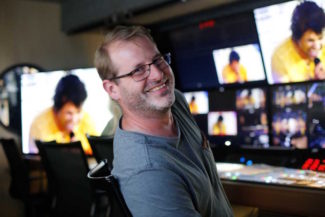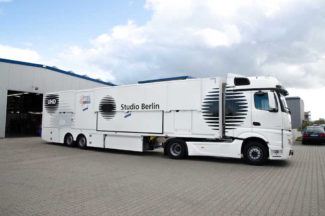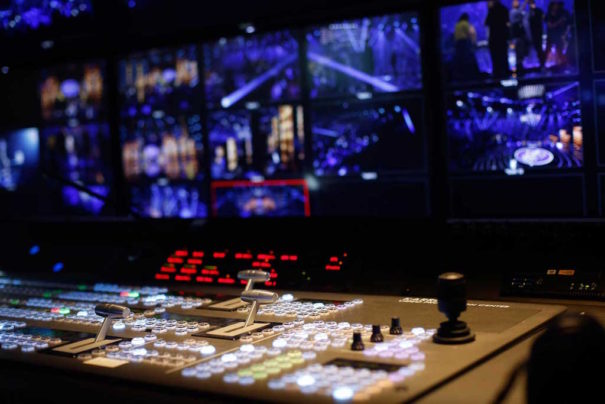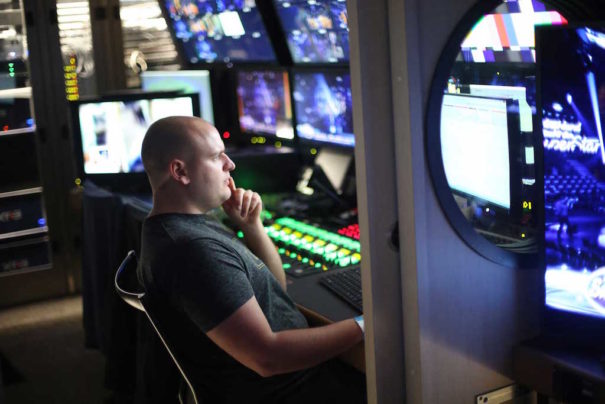Studio Berlin realiza en Ultra Alta Definición con HDR la final de ‘DSDS’ (‘Idol’) en Alemania
Studio Berlin empleó su unidad móvil OB9 diseñada e integrada por Broadcast Solutions con tecnología de Grass Valley, Sony y Riedel. Es la primera vez en Europa que se produce en directo un talent show en prime-time en Ultra Alta Definición con alto rango dinámico (HDR).
La nueva unidad móvil OB9 de Studio Berlin por encargo de UFA ha producido la final de DSDS – Deutschland sucht den Superstar, un talent show franquicia de Idol, en Ultra Alta Definición con alto rango dinámico (HDR). La emisión fue difundida simultáneamente en HD/SDR y UHD/HDR en dos canales de RTL Alemania.
Esta unidad móvil, fue diseñada e integrada por Broadcast Solutions por encargo de Studio Berlin a principios de 2017 para trabajar en producciones tan elaboradas en UHD y HDR de forma flexible y sencilla. Para la producción de la final del DSDS, OB9 se situó en los estudios MMC de Colonia y produjo la señal UHD/HDR in situ.
 Ernst Feiler, director de tecnología de UFA, ha destacado que “por primera vez en la historia de la televisión se retransmitió en directo un gran programa del sábado por la noche en UHD/HDR. En caso de grandes espectáculos con gran despliegue de luz y teatro se demuestra el enorme potencial visual y emocional del nuevo estándar UHD/HDR. Sin la larga experiencia de Studio Berlin en la producción de programas de televisión en directo y su conocimiento de la Ultra Alta Definición, este estreno no habría sido posible”.
Ernst Feiler, director de tecnología de UFA, ha destacado que “por primera vez en la historia de la televisión se retransmitió en directo un gran programa del sábado por la noche en UHD/HDR. En caso de grandes espectáculos con gran despliegue de luz y teatro se demuestra el enorme potencial visual y emocional del nuevo estándar UHD/HDR. Sin la larga experiencia de Studio Berlin en la producción de programas de televisión en directo y su conocimiento de la Ultra Alta Definición, este estreno no habría sido posible”.
Nick Zimmermann, director general de Studio Berlin, añade que “nos enfrentamos a un gran reto con la producción en directo de la final de DSDS en UHD/HDR. Sin embargo, al invertir en nuestra nueva unidad OB9, estábamos técnicamente bien preparados para el trabajo, y la unidad nos puso en posición de implementar con éxito un flujo de trabajo tan innovador. La competencia de Studio Berlin en la realización de grandes espectáculos de entretenimiento fue otro factor que contribuyó a este exitoso estreno europeo. El apoyo de todos los fabricantes de hardware durante la planificación y la implementación fue excepcional”.
Matthias Alexandru, director técnico de Studio Berlin, sobre el aspecto técnico de la producción, asegura que “la tarea era producir la señal HD en su flujo de trabajo existente sin cambios durante la transmisión en vivo. Por lo tanto, la señal UHD/HDR debía generarse de forma independiente. Para lograrlo, decidimos separar completamente las producciones de las señales HD y UHD/HDR”.
Señal simultánea HD/UHD
La producción de la final DSDS se realizó en paralelo desde el control permanente del MMC (HD/SDR) y la sala de control de la móvil OB9 (UHD/HDR). Como de costumbre, se utilizaron 13 cámaras en la final de DSDS. Sin embargo, ahora se utilizaban cámaras Grass Valley LDX 86N. Para la producción de la señal HD y el equipo en la sala de control fija, este fue el único cambio con respecto a las producciones anteriores.
Estas cámaras transmitían simultáneamente una señal HD para la sala de control del estudio y una señal UHD/HDR para el control de la unidad móvil de Studio Berlin. Las XCUs de las cámaras se instalaron en la sala de control fija, para asegurar la conexión de comandos y Tally como es habitual. Las XCUs entregaban simultáneamente una señal UHD/HDR y otra HD/SDR. Esto permitió que ambas salas de control tuvieran acceso a las mismas cámaras.
 El control del LDX 86N tuvo lugar tanto en la sala de control fija para la señal HD como en la sala de control de la unidad móvil para la señal UHD/HDR. El conjunto de características de la cámara permite un cambio independiente de los parámetros del formato respectivo. Un equipo de expertos de Grass Valley estuvo en el lugar durante la instalación y producción, contribuyendo al éxito de la producción.
El control del LDX 86N tuvo lugar tanto en la sala de control fija para la señal HD como en la sala de control de la unidad móvil para la señal UHD/HDR. El conjunto de características de la cámara permite un cambio independiente de los parámetros del formato respectivo. Un equipo de expertos de Grass Valley estuvo en el lugar durante la instalación y producción, contribuyendo al éxito de la producción.
La señal UHD/HDR se transmitió en directo gracias al uso de equipamiento de Nevion Equipment hasta el CBC Cologne Broadcasting Center en Colonia.
Un mezclador Karrera de Grass Valley utilizado en la unidad móvil se controlaba de forma remota a través de la sala de control fija del estudio. El uso manual solo se producía en determinadas escenas del espectáculo, como el uso de efectos de vídeo digital. La edición de la señal de audio también se llevó a cabo en la sala de control del estudio.
Durante la producción, Studio Berlin se apoyó en los monitores Sony BVM-X 300. Usando la señal de retorno del satélite en vivo, los equipos de la unidad móvil comprobaron la calidad del UHD con pantallas LG y Samsung UHD. Por lo tanto, durante la producción ya era posible determinar cómo se comportarían los televisores de diferentes fabricantes en casa de los espectadores.
La unidad móvil OB9 fue desarrollada por Broadcast Solutions partiendo del concepto Streamline y está diseñado como una unidad S16 combinando el uso de las últimas tecnologías 4K/UHD, HDR e IP-workflow. La OB9 puede trabajar en ambos formatos HD/SDR y UHD/HDR. Esta unidad es uno de los primeros modelos Streamline en los que Broadcast Solutions ha incorporado la solución MediorNet de Riedel para el procesamiento de vídeo, operando como una red troncal de comunicaciones y enrutamiento de señales distribuidas con routers MetroN y sistemas multiviewer MicroN Standard +.
Related news:
La producción remota de fútbol se consolida en UK con Simplylive de Riedel: hasta 30 partidos simult...
Así es Sony Virtual Production Studio, un plató VP con la última tecnología cinematográfica
‘Mar i cel’ (3Cat): la demostración de que los límites entre cine y televisión ya no tienen sentido
La serie Ninja TX de Atomos estrena control integrado de cámara
Jesús Haro: ‘Zoomers’, los juguetes tecnológicos y el aprendizaje eterno
Venice Mini, Burano, FX2 y un prototipo de cámara de Sony, al descubierto en EnergaCameraimage 2025
Cabal Esports y Lastlap lideran la producción de la gran final europea de 'League of Legends' en Mad...
El Campeonato Europeo de Balonmano 2026 desplegará la tecnología de cámaras POV RefCam para árbitros...
Broadcast Solutions reorganiza su equipo directivo
Sony responde a la era “deepfake” con un sistema de verificación de autenticidad de vídeo dirigido a...
Ulrich Voigt, nuevo responsable del negocio SimplyLive de Riedel
Pau Esteve Birba y la fotografía de ‘Los Tigres’: la luz y el color, dentro y fuera del agua
WWTV connects two headquarters separated by 80 kilometers with IP technology and the Arcadia intercom (Clear-Co...
Broadcast Solutions' flagship mobile unit lands at Brutal güet: UHD, three rooms, internal positions...
ARTE da el salto a la producción IP con cámaras LDX 135 y flujos de trabajo SMPTE ST 2110
Sapec incorpora a David Lois como responsable de ventas EMEA
Did you like this article?
Subscribe to our NEWSLETTER and you won't miss anything.




